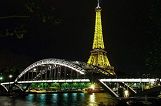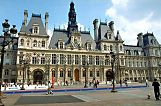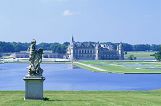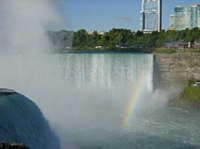by Rick Steves
Resources for Traveling with Kids in Europe
Common sense and lessons learned from day trips at home are your best sources of information.
Take Your Kids to Europe is full of practical, concrete lessons from firsthand family-travel experience, and the only good book I've seen for those traveling with kids ages 6–16 (by Cynthia Harriman, Globe Pequot Press, 8th edition, 2007).
The best book I've found on traveling with infants is Lonely Planet's Travel with Children (5th edition, 2009), which covers travel worldwide, including Europe.
For families interested in hiking, biking, and sailing abroad, pick up Adventuring With Children: An Inspirational Guide to World Travel and the Outdoors (by Nan Jeffrey, Avalon House, 1995). Cadogan offers many worthwhile books in its Take the Kids series, including books on London, Paris, Ireland, and more.
Also consider:
* Fodor's Around London with Kids, Around Paris with Kids, Around Rome with Kids, and Family Adventures.
* For solo parents, there's Brenda Elwell's Single Parent Travel Handbook (Globalbrenda Publishing, 2002).
European families, like their American counterparts, enjoy traveling. You'll find more and more kids' menus, hotel playrooms, and kids-go-crazy zones at freeway rest stops all over Europe. Your child will be your ticket to countless conversations. Traveling with an infant or toddler can be challenging, but parents with a babe-in-arms will generally be offered a seat on crowded buses, and sometimes be allowed to go to the front of the line at museums.
Grade-school kids are often the easiest travelers, provided you schedule some kid-friendly activities every day. They're happiest staying in rural places with swimming pools and grassy fields to run around in.
High-schoolers feel that summer break is a vacation they've earned. If this European trip is not their trip, you become the enemy. They crave the bright lights and action of the big city. Ask for their help. Kids can get excited about a vacation if they're involved in the planning stages. Consider your child's suggestions and make real concessions. "Europe's greatest collection of white-knuckle rides" in Blackpool might be more fun than another ruined abbey.
My kids are young adults now, but I remember what it was like taking them to Europe. In this chapter, I've included the lessons I've learned from parenting in Europe, along with tips collected from readers on this website's Graffiti Wall.
International adventure is a great foundation for a mountain of memories. The key to a successful family trip is making everyone happy, including the parents.
Planning
You'll need the proper documents. Even babies need passports. If you're traveling with a child who isn't yours (say, a niece or grandson), bring along a signed, notarized document from the parent(s) to prove to authorities that you have permission to take the child on a trip.
It's a good idea to take extra passport photos with you. Since infants and toddlers change so quickly, carry photos that were taken for the passport, as well as ones taken close to your departure date. For children at any age, take an official copy of his or her birth certificate, along with a photocopy of the child's passport. Keep these separate from your passports — these documents will allow you get a replacement passport for your child quickly and easily.
Most parents hold onto their kids' passports, but if you have older children that will be out on their own, you might get them a money belt or neck pouch for carrying their cash and ID.
You'll find that because you are in a foreign country, your kids are more likely to stick close to you. But if you're worried about your younger children getting lost, consider ordering dog tags with contact information (see www.dogtagsonline.com). Give each child a business card from your hotel so they have local contact information. Another option is a ID Inside wristband, with a hidden pocket that holds a disposable, waterproof ID card. You can easily switch out the ID card, updating your hotel name and contact information as you travel. Or try the Lost & Found Temporary Tattoo, a washable tattoo with a space for you to write a contact phone number.
At home, encourage your kids to learn about the countries, cities, sights, and people they'll be visiting. Even simple Wikipedia articles can provide enough background to pique a child's curiosity. Read books such as The Diary of Anne Frank for Amsterdam or The Thief Lord for Venice. Watch movies together, such as The Sound of Music for Salzburg, The Red Balloon for Paris, or The Secret of Roan Inish for Ireland. Your hometown library can be a great resource for age-appropriate books and movies.
Get a jump on foreign phrases, learning the top 20 or so before you leave home. Capitalize on whatever hobbies your kids have or games they play that may relate to the history of the places you're visiting, especially if your family has some sort of connection to the "old country." Give them the chance to try out foreign specialties in advance by eating at ethnic restaurants, or get a cookbook and make meals together at home. Many US cities host celebrations of different cultures — look for Greek, French, Italian, Hungarian, or other European festivals in your town for your family to enjoy.
What to Bring
The amount of gear you need depends on the age of your child. Since a baby on the road requires a lot of equipment, the key to happiness is a rental car or a long stay in one place. If you're visiting friends or family, give them ample notice, and they may be able to borrow a car seat, stroller, and travel crib so you won't have to pack it. If you have older kids, let them know they will be pulling their own roll-aboard luggage through airports and down cobblestone streets. Pack as light as you can, but if you figure you'll need it (based on your experience taking trips near home), trust your judgment.
For young kids, it's helpful to have a stroller and a baby backpack. The light umbrella strollers can easily navigate cobblestones — just make sure you spend a little extra on a solidly built one that can take the bumps, such as Peg Pérego or Maclaren. Backpacks are great if you need to keep your hands free, and when you're traveling on subways and buses. Prepare to tote more than a tot. A combo purse/diaper bag with shoulder straps is ideal. You can always stow it in your stroller's basket if you tire of carrying it yourself. Be on guard: Purse snatchers target parents (especially while busy and off-guard, as when changing diapers).
Some parents bring a travel bed, although hotels can usually supply a crib (ask in advance when you reserve the room). One travel model — PeaPod Plus — is a pop-up tent with an air mattress, sleeping bag, and hand pump (www.kidco.com). Other parents use a portable playpen as a bed for their child. Bringing a travel bed means your child never has to sleep in a "strange" bed — avoiding possible sleeping problems. However, carting around a travel bed or playpen makes more sense if you'll be traveling by car.
Drivers should bring a car seat, buy one in Europe, or see if the car-rental company can provide one (usually the most expensive option). Pack along a car-seat clip in case you need to secure the car seat to the shoulder-strap seat belt. In addition to being required safety equipment while driving, a car seat can be a stress-saver when traveling by plane, train, or bus. Although it may seem like a bulky carry-on, a car seat is more comfortable for your child to sit in than a seat designed for an adult, and is a familiar place for a nap. Kids are used to car seats and know how to behave in them.
If your child uses formula, consider bringing your own supply — the formula offerings in most of Europe are very different from those at home. Before you fly away, be sure you've packed acetaminophen, diaper rash cream, a thermometer, and any special medications your baby may need (keeping in mind the air travel rules about liquids).
For older kids, today's technology can make the difference between a dream trip and a nightmare. Splurge for a portable DVD player or iPod. Load it with movies and TV shows, and get a splitter so two kids can watch at the same time. There's nothing like a favorite show to help calm your kids before bedtime. A Nintendo DS or other handheld game system can fill hours traveling between destinations. Consider giving each of your kids his or her own digital camera or cheap video camera. They can take pictures and make movies from their own perspective. Along with their journals, it will help them remember more about the trip. Bring the family laptop or netbook; you'll find that your teens will use it (more than you) to stay in touch with friends back home.
You can easily buy toys and sports equipment in Europe. For the athletic child, a Whiffle ball and bat guarantee hours of amusement with newfound friends. A rubber ball lets kids play soccer on foreign turf. When you're in France or Italy, consider purchasing a set of boules or pétanque balls (called bocce in Italy); this popular form of outdoor bowling is played on public squares. (The balls are heavy, though, so only get them if you're staying in one place or traveling by car.)
For quiet time in the hotel room, buy a set of Legos once you're in Europe — the popular building blocks are excitingly different from those found in the US. A small indoor Frisbee is fun.
But don't overdo it. One family of four reported taking three suitcases, two backpacks, and a stroller to Spain. European taxis are much smaller than American ones, so every time they traveled between cities, they had to use two taxis to transfer to the airport or train station. Even with kids, you can pack light. Make the older ones carry their own bags. Do laundry more often. If there's a sudden cold snap, buy an extra sweater in Europe rather than bring one along.
In the Air
Your cute gurgling baby might become an airborne Antichrist as soon as the seat-belt light goes off. You'll pay 10 percent of the ticket cost to take a child under the age of two on your lap for an international flight. The child doesn't get a seat, but many airlines have baby perks for moms and dads who request them in advance — roomier bulkhead seats, hang-from-the-ceiling bassinets, and baby meals. (Note, however, that many child-safety experts advise against holding a baby in your lap on the plane, and suggest that you buy a ticket and strap your child into his or her car seat instead.)
After age two, a child's ticket typically costs 60–80 percent of the adult fare — a major financial ouchie (some sale fares do not allow any discounts for kids). From age 12 on, kids pay full fare.
For long flights, choose a red-eye when possible so your child (and hopefully you) can sleep while you travel. Pick flights with few connections; nonstop works best. Decide if you want to sit near the aisle or window. A window seat gives your active child only one escape route, plus the added entertainment of the window. However, a toddler who needs frequent diaper changes and sits quietly may be more comfortable by the aisle.
Tire out your tykes before boarding the plane. If you fly at night, consider having your child skip that afternoon's nap. While you're waiting to board, get your kids up and moving as much as possible. Finally, when you're on the plane and it's time for sleep, follow normal bedtime routines. Change your child into pajamas, tuck her in with a blanket, and read a story or two.
Be prepared. The batteries might go out on your DVD player or iPod. For younger kids, make sure to have lots of toys and surprises, such as a Mini Slinky or stickers. Bring snacks (such as raisins and granola bars), activity supplies (washable markers, paper, various activity books — mazes, connect-the-dots, Mad Libs), books for reading, and small stuffed toys.
Be warned — jet lag can be kiddie purgatory. If you can tolerate some — OK, maybe a lot — of crankiness on the first day, keep young children awake until a reasonable bedtime. After junior passes out from exhaustion, hopefully the whole family will sleep through the night and wake up when the locals do. Take it easy at the beginning (maybe even starting with a rural destination), allowing a couple of low-impact days to get over jet lag.
Lodging
Some kids do better staying in an apartment or house than in a hotel. Self-catering flats rented by the week or two-week period, such as gîtes in France and villas in Italy, give a family a home on the road. To cut costs, try home-sharing services that let you swap houses with a European family (see a letter I received that's full of House-Swapping Tips). Many families prefer settling down this way and side-tripping from a home base. Not only is it cheaper, but you get to spend time together cooking, watching movies, and just hanging out. It's a cultural experience just to see European TV together. But be aware that European standards on televised sex and nudity are much more relaxed than in the US; you might stumble on some uncensored movies, or even soft-core porn, next to the Nickelodeon channel.
If you're traveling with older kids, consider hostels. Families can hostel very cheaply, especially in high-priced Scandinavia. Family membership cards are inexpensive, and there's no age limit. Many hostels have "members' kitchens" where the family can cook and eat for the price of groceries. Some hostels also offer family rooms.
If your kids love camping, rent a camper van or small RV. Kids and campgrounds — with swings, slides, and plenty of friends — mix wonderfully. Suddenly your family and the French kids over at the next tent are best buddies (see my article on Camping European Style).
Most hotels, especially those catering to business travelers, have large family rooms. London's big, budget chain hotels allow two kids to sleep for free in their already reasonably priced rooms. A swimming pool is a bonus at these chain hotels.
In some countries, you may need to know the necessary phrases to communicate your needs. If you have a family of four and your children are young, request a triple room plus a small extra child's bed. Traveling with teenagers, you may need two rooms: a double (one big bed) and a twin (a room with two single beds). In much of Europe, a "double" bed is actually two twins put together. These can easily be separated.
Be careful about staying in small hotels or B&Bs with a baby. If your child wakes up in the middle of the night, you're going to wake up everybody else. Some B&Bs won't take even children, or impose an age limit (such as no kids under 8); ask before booking.
Choosing lodging close to your daytime activities is smart in case your little traveler needs to return for a nap or supplies. Request quiet rooms away from the street and bar downstairs. If your child is used to sleeping in his or her own space, look for rooms with a partition, large closet, or other area in which you can separate your child when it's bedtime (baby can even sleep in the bathroom).
If you have young children, childproof the room immediately on arrival. A roll of masking tape makes quick work of electrical outlets. Place anything breakable up out of reach. Proprietors are generally helpful to considerate and undemanding parents.
With a toddler, budget extra to get a bath in your room — a practical need and a fun diversion. (Some showers have a 6-inch-tall "drain extension" and a high lip to create a kid-friendly bathing puddle.)
Food
Keep children fed. Even with a big breakfast, don't expect them to "power through" to a late lunch. A short snack break will help in the long run. Make sure to pack along or stop to buy high-quality food as often as possible — a real sandwich, pasta, or yogurt.
Buying bread, cheese, fruit, and drinks in the morning means you can picnic anytime, anywhere. Kids find that foreign grocery stores are an adventure, so bring them along and let them help shop. Get take-away food from one of the many (usually cheap) food stands in big cities — French fries, bratwurst or Currywurst, crêpes, or a sandwich.
Eat gelato, croissants, or chocolate every day (gelato should be twice a day) — whatever is a "specialty" treat of the country you are in. It's a cultural experience and a great way to get off your feet and take a break.
At home, you may try to avoid bribes, but the promise of a treat can make a huge difference to everyone's cooperation when you're out and about — and don't have space for a "time out."
An occasional Big Mac or Whopper between all the bratwurst and kraut helps keep the family happy. You'll get your food relatively quickly, and the kids will almost always eat hamburgers, fries, or chicken nuggets. As much as adults love eating at European restaurants, kids get restless. The pacing is slow, and it can be stressful. Plan ahead and bring something for your child to do while waiting for dinner (or the check) to arrive.
Eat dinner early (around 6–7 p.m.) to miss the romantic crowd. Skip the famous places. Look instead for relaxed cafés or pubs (kids are welcome, though sometimes restricted to the restaurant section or courtyard area). Don't expect high chairs to be available; use your stroller in a pinch.
In restaurants (or anywhere), if your infant is making a disruptive fuss, apologetically say the local word for "teeth" (dientes in Spanish, dents in French, denti in Italian, Zähne in German), and annoyed people will become sympathetic.
At fancier hotels, you can get babysitters, usually from professional agencies. The service is expensive but worth the splurge when you crave a leisurely, peaceful evening out.
Activities
Review the day's plan at breakfast with the entire family. It should always include a kid-friendly activity. Hands-on tours, from cheesemaking to chocolate factories, keep kids engaged. Go to sports or cultural events, but don't insist on staying for the entire event.
Kids need plenty of exercise. Allow time for a few extra runs on the luge. Small towns often have great public swimming pools, and big cities have recreation centers or water parks (check out Paris' Aquaboulevard). Mountain bikes are easily rentable (with helmets), suddenly making the Alps cool. Local TIs can help you dig up these treats.
Let your kids make decisions: choosing lunch spots, deciding which stores to visit. (The cheapest toy selection is usually in the large department stores.) Turn your kid into your personal tour guide and navigator. If you use my guidebooks, have your child lead you on my self-guided walks and museum tours.
Europe is full of kiddie discounts, but you have to ask. Many activities — most importantly train rides — are free for infants and toddlers. School-aged children often fall into the reduced fare category, but sometimes they ride free, too. Some museums are free for kids under a certain age. When adults have to pay to eat breakfast at hotels, their kids sometimes eat free — worth a whole lot of money, especially when you're in Scandinavia.
Since a trip is a splurge for the parents, the kids should enjoy a larger allowance, too. Provide ample money and ask your kids to buy their own treats, gelati, postcards, and trinkets within that daily budget. In exchange for the extra allowance, require them to keep a daily journal or scrapbook. Expect older kids to carry and use the currency. If you don't want your younger child to carry cash, Mom or Dad can be the "banker" and keep a tally of expenses.
Help your kids collect and process their observations. If you buy the actual journal at your first stop, it becomes a fun souvenir in itself. Kids like cool books — pay for a nice one. The journal is important, and it should feel that way. Encourage the kids to record more than just a trip log...collect feelings, smells, tastes, reactions to cultural differences, and so on. Grade-school kids enjoy pasting in ticket stubs or drawing pictures of things they've seen.
Young kids will do better in museums if you let them buy postcards in the gift shop first and then have a scavenger hunt to find the artwork on their postcards. "I spy" games are also a fun way to get the kids to pay attention when they start to get bored. Have the younger ones count how many babies they can find in all the paintings in the room — or dogs, or crowns. Follow my crowd-beating tips on easy entry to major sights — kids despise long lines even more than you do.
Older kids enjoy audioguides available at the museum or my free podcasts. Audioguides let your kids feel independent in their sightseeing. They also allow you a few moments to learn about the artwork, too.
Try a guided walking tour. Some parents are leery of group tours because they're afraid their kids will be the most disruptive members. But your kids will listen to a guide more than they will listen to you. Being in a group of adults can tone down even the wildest child.
Consider visiting an amusement park as an end-of-trip reward — the promise of Legoland in Denmark, Blackpool in England, or Disneyland Paris can keep your kids motoring through the more mundane attractions. In parks, look for puppet shows, pony rides, merry-go-rounds, small zoos, or playgrounds. Paris's Luxembourg Gardens is renowned for its toy sailboat rentals at the main pond (and they'll even let your kids play on the grass — usually a no-no at French parks).
At least every other day, take an extended break. Return to your hotel or apartment after lunch for two hours for napping, reading, or listening to the iPod. What you lose in sightseeing time you will gain in energy levels.
It can be hard for kids to hang around grown-ups all day, so help your kids connect with other children. In hot climates, kids hang out on the squares (in cities and villages alike) when the temperature begins to cool in the late afternoon, often staying until late in the evening. Take your children to the European nightspots to observe — if not actually make — the scene (such as the rollerbladers at the Trocadéro in Paris or the crowd at Rome's Trevi Fountain).
Just a few phrases spoken by your kids will open many doors. Made a point of teaching them "thank you," "hello," and "good-bye" in the country's language. You'll find nearly everyone speaks English, but small phrases out of the mouths of babes will melt the cool of surly museum guards or harried shop clerks.
Internet cafés allow kids to keep in touch with friends at home and European pals they meet on their trip. These days, blogging is popular and accessible even for kids (see my artcle on Communication over the Internet). Or, for a few euros, kids can purchase an international phone card and chat cheaply with friends back home. If you're traveling with a mobile phone, your kids can use it to text or send photos back to their friends in the US.
Getting somewhere can be more fun than touring a sight. Your son might not care about the Crown Jewels, but he may go nuts riding the double-decker bus getting there. Kids love subway maps, train schedules, and plotting routes. The Paris Métro is especially fun, as many stations have boards that light up the route when you press the button for your destination. Even the automated ticket kiosks are entertaining. Allow time for all of this, rather than just rushing onto a subway train or bus. After a teaching run, let your child actually lead the family on subway journeys — kids love the challenge.
In a crowded situation, having a unique family noise (a whistle or call, such as a "woo-woop" sound) enables you to easily get each other's attention. Consider buying cheap walkie-talkies in Europe to help you relax when the kids roam (don't bring walkie-talkies from home, as ours use a different bandwidth and are illegal in Europe). Or consider buying a cheap "pay as you go" mobile phone for them in Europe (explained in my article on Mobile Phones in Europe); this can also be helpful in case of emergencies.
When using public transportation, have a backup plan for what to do in case you get separated in the crowd or if one of you gets off the Metro before the other (for example, plan to meet at the next stop — or, if all else fails, plan to reconvene at the hotel — make sure everyone has a hotel business card).
Public WCs can be hard to find. Try department stores, museums, and restaurants, particularly fast-food places.
This is not the United States of Litigation. Europeans love children, but their sense of child-proofing public spaces is vastly different from ours. You may find a footbridge across a raging river has child-sized gaps between the railings. Windows in fourth floor hotel rooms may be easy to open and unscreened. The hot water may scald you in about 30 seconds. Don't judge. But do pay attention.
Leave the Kids at Home?
When parents tell me they're going to Europe and ask me where to take their kids, I'm tempted to answer, "to Grandma and Grandpa's on your way to the airport." It's easy to make the case against taking the kids. Traveling with kids is expensive. (Starting at age 12, they fly for full fare. Out of exhaustion and frustration, you may opt for pricey conveniences like taxis and the first restaurant you find with a kid-friendly menu.) And two adults with kids spend twice as much to experience about half the magic of Europe per day that they might without. Also, older kids would very often rather stay home to enjoy their school break with friends.
If you and your partner have 20 days for a family vacation, are on a budget, and are dreaming of an adult time in Europe, consider this plan: Go for 10 days without the kids and really enjoy Europe as adults rather than parents — the savings from leaving them at home will easily cover top-notch child care. Then fly home and spend the other 10 days with your kids — camping, at a water park, or just playing with them at home. (If your kids have a "cool" but responsible young-adult relative somewhere else in the US who they'd enjoy getting to know better, offer to pay to fly them there and watch your kids while you're gone.)
Some parents won't bring their kids until they are old enough to enjoy the trip. They should be able to stand a day of walking and be ready to eat what is in front of them — and sleep where you stay. They should be able to carry their own daypacks with some clothes, journal, and a couple of toys. It's about the same age as when a child is ready for a long day at Disneyland.
You'll find your European trips will definitely change with children, but many parents wouldn't dream of leaving their kids behind. Your vacation will be much more about playgrounds and petting zoos than about museums and churches. Some of your best memories may be of your son playing in a sandbox with the girls who live next to your rental cottage, or your daughter going on a zip line at the local playground. Traveling with kids, you'll live more like a European and less like a tourist. And, if done well, you'll take home happy memories that you'll share for a lifetime.







